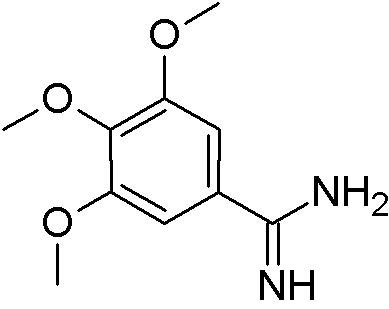3,4,5-Trimethoxy-benzamidine is widely utilized in research focused on:
- Pharmaceutical Development: This compound is often explored for its potential as a drug candidate due to its unique structural properties that may enhance bioactivity against various diseases.
- Biochemical Research: It serves as a valuable tool in studying enzyme inhibition and protein interactions, helping researchers understand complex biological processes.
- Agricultural Chemistry: The compound can be investigated for its efficacy in developing new agrochemicals aimed at pest control, providing safer alternatives to traditional pesticides.
- Material Science: Its properties may be leveraged in the development of novel materials, particularly in creating polymers with enhanced thermal and chemical resistance.
- Analytical Chemistry: This chemical can be used as a standard in various analytical methods, aiding in the accurate quantification of related compounds in complex mixtures.
General Information
Properties
Safety and Regulations
Applications
3,4,5-Trimethoxy-benzamidine is widely utilized in research focused on:
- Pharmaceutical Development: This compound is often explored for its potential as a drug candidate due to its unique structural properties that may enhance bioactivity against various diseases.
- Biochemical Research: It serves as a valuable tool in studying enzyme inhibition and protein interactions, helping researchers understand complex biological processes.
- Agricultural Chemistry: The compound can be investigated for its efficacy in developing new agrochemicals aimed at pest control, providing safer alternatives to traditional pesticides.
- Material Science: Its properties may be leveraged in the development of novel materials, particularly in creating polymers with enhanced thermal and chemical resistance.
- Analytical Chemistry: This chemical can be used as a standard in various analytical methods, aiding in the accurate quantification of related compounds in complex mixtures.
Documents
Safety Data Sheets (SDS)
The SDS provides comprehensive safety information on handling, storage, and disposal of the product.
Product Specification (PS)
The PS provides a comprehensive breakdown of the product’s properties, including chemical composition, physical state, purity, and storage requirements. It also details acceptable quality ranges and the product's intended applications.
Certificates of Analysis (COA)
Search for Certificates of Analysis (COA) by entering the products Lot Number. Lot and Batch Numbers can be found on a product’s label following the words ‘Lot’ or ‘Batch’.
*Catalog Number
*Lot Number
Certificates Of Origin (COO)
This COO confirms the country where the product was manufactured, and also details the materials and components used in it and whether it is derived from natural, synthetic, or other specific sources. This certificate may be required for customs, trade, and regulatory compliance.
*Catalog Number
*Lot Number
Safety Data Sheets (SDS)
The SDS provides comprehensive safety information on handling, storage, and disposal of the product.
DownloadProduct Specification (PS)
The PS provides a comprehensive breakdown of the product’s properties, including chemical composition, physical state, purity, and storage requirements. It also details acceptable quality ranges and the product's intended applications.
DownloadCertificates of Analysis (COA)
Search for Certificates of Analysis (COA) by entering the products Lot Number. Lot and Batch Numbers can be found on a product’s label following the words ‘Lot’ or ‘Batch’.
*Catalog Number
*Lot Number
Certificates Of Origin (COO)
This COO confirms the country where the product was manufactured, and also details the materials and components used in it and whether it is derived from natural, synthetic, or other specific sources. This certificate may be required for customs, trade, and regulatory compliance.


